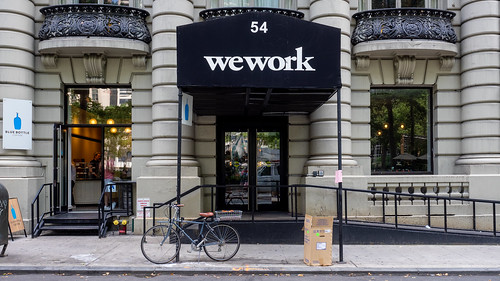
Remember WeWork? Its value has collapsed since the halcyon days, and it’s still losing money. Has anyone learnt any lessons from it? CC-licensed photo by Ajay Suresh on Flickr.
You can sign up to receive each day’s Start Up post by email. You’ll need to click a confirmation link, so no spam.
It’s Friday, so there’s another post due at the Social Warming Substack at about 0845 UK time. It’s about the E.coli of the internet.
A selection of 11 links for you. Use them wisely. I’m @charlesarthur on Twitter. On Mastodon: https://newsie.social/@charlesarthur. Observations and links welcome.
Intel reports largest quarterly loss in company history • CNBC
Kif Leswing:
»
Intel reported first-quarter results on Wednesday that showed a staggering 133% annual reduction in earnings per share. Revenue dropped nearly 36% year-over-year to $11.7bn.
Still, the loss per share and sales were slightly better than soft Wall Street expectations. The stock fluctuated in extended trading after initially rising on the report.
Here’s how Intel did versus Refinitiv consensus expectations:
• Loss per share: Loss of 4c per share, adjusted, versus a loss of 15c per share expected
• Revenue: $11.7bn, adjusted, versus $11.04bn expected.Intel’s guidance for the current quarter of about $12bn in revenue and a 4c loss per share came up short versus analyst expectations of 1c in earnings per share on $11.75bn in sales.
Intel recorded a net loss of $2.8bn, compared with a profit of $8.1bn last year. GAAP revenue decreased to $11.7bn from $18.4bn. It’s the fifth consecutive quarter of falling sales for the semiconductor giant and the second consecutive quarter of losses.
It’s also the largest quarterly Intel loss of all time, beating out the fourth quarter of 2017, where Intel reported a loss of $687m.
…Intel hopes that by 2026 that it can manufacture chips as advanced as those made by TSMC in Taiwan, and it can compete for custom work like Apple’s A-series chips in iPhones. Intel said on Thursday it was still on track to hit that goal.
«
PC chip sales down 38%, server chip sales down 39%, Network and Edge down 30%. CEO Pat Gelsinger really needs to pull the plane out of the dive.
unique link to this extract
April 1994: Killing spreads in Rwanda • BBC On This Day
April 1994:
»
The ethnic violence in the Rwandan capital Kigali is now spreading throughout the country, aid officials have said.
Tens of thousands of people are believed to have died since Rwanda’s president died in a suspicious plane crash on 6 April.
The killing has mainly been carried out by Hutu gangs, who blame Tutsi rebels for downing President Juvenal Habyarimana’s plane in a rocket attack. The President of Burundi was also killed.
Witnesses in Kigali say Hutu soldiers have been hacking Tutsi civilians to death with machetes in the street.
A spokesman for the International Committee of the Red Cross, Jean-Luc Thevoz, said hundreds of thousands of Rwandans had also been forced to leave their homes by the violence.
“The situation is catastrophic, not just in Kigali, but in the rest of Rwanda,” he said.
About 3,600 rebels from the mainly Tutsi Rwanda Patriotic Front (RPF) have infiltrated the capital. The group has said it will continue to fight until the Hutu-dominated government stops the massacres.
The RPF is currently moving to take the city and has blown up a radio station that it said was broadcasting propaganda inciting Hutus to slaughter Tutsis.
«
Incitement to genocide via radio: this was the awful precedent.
unique link to this extract
Raccoon dogs in Wuhan ‘did not spread Covid to humans’ • Daily Telegraph
Sarah Knapton:
»
Raccoon dogs blamed for the Covid pandemic were not responsible, new analysis suggests, after samples at a Wuhan market were found to contain virtually no virus.
Last month a controversial study suggested that raccoon dog DNA found at the Huanan Seafood Wholesale Market in January 2020 was mixed with Covid-19, providing “strong evidence” that coronavirus jumped to humans from the animals.
The paper was based on swabs taken by Chinese researchers in the market at the start of the pandemic which were recently uploaded to an international database. The authors said it pointed to a zoonotic origin for the pandemic rather than a laboratory leak.
But a new in-depth genetic analysis of the samples by respected computational virologist Dr Jesse Bloom, of Fred Hutchinson Cancer Center in Seattle in the US, showed there is barely any Covid-19 intermixed with raccoon dog DNA.
Of the 14 raccoon dog samples studied, 13 had no Covid-19 at all, while one had just one fragment of virus per 200 million fragments of animal DNA.
In contrast, the virus was found in greater quantities mixed with human DNA, as well as species such as largemouth bass, catfish, cow, carp, and snakehead fish, none of which could pass the virus to humans.
The team concluded there was actually a “negative correlation” between Covid-19 and raccoon dog DNA.
Dr Bloom also warned that the samples were taken several weeks after the first Covid cases emerged in Wuhan at a time when Covid-19 had already been spread widely across the market by humans.
“What can we conclude about Covid-19 origins from all this? Probably not much,” he said.
“We should analyse everything, but these data don’t tell us how the pandemic began.
«
Bloom is reliable; this essentially wipes the slate clean again and puts us back on the starting blocks. As Bloom says, this doesn’t answer the question. We still need more data. Anyhow, raccoon dogs can walk tall again (while avoiding people looking to trap them and sell them in wet markets).
unique link to this extract
Dropbox is laying off 500 people and pivoting to AI • The Verge
Emma Roth:
»
Dropbox is laying off around 500 employees, making up about 16% of the company’s entire workforce. In a memo to employees, Dropbox CEO Drew Houston attributes the layoffs to a rocky economy — but also says that the cuts will allow the company to build out its AI division.
“In an ideal world, we’d simply shift people from one team to another. And we’ve done that wherever possible,” Houston writes. “However, our next stage of growth requires a different mix of skill sets, particularly in AI and early-stage product development. We’ve been bringing in great talent in these areas over the last couple years and we’ll need even more.”
As part of the change, Houston says Dropbox will consolidate its core and document workflow businesses, and that it’s also making adjustments to its product development teams. Houston adds that Dropbox is still “profitable” despite rough economic times and that the job cuts are part of the “natural maturation” of the Dropbox business.
“The changes we’re announcing today, while painful, are necessary for our future,” Houston notes. “I’m determined to ensure that Dropbox is at the forefront of the AI era, just as we were at the forefront of the shift to mobile and the cloud. We’ll need all hands on deck as machine intelligence gives us the tools to reimagine our existing businesses and invent new ones.”
«
Just as well they were making the cuts now. If it had been six months ago, they’d have been building out their metaverse division. But now it’s AI, which everyone loves (not like that metaverse garbage – ugh), and definitely needs to be incorporated somehow (details TBD) into their file-sharing product.
unique link to this extract
Employers reveal why Gen Z is the hardest generation to work with • NY Post
Rikki Schlott:
»
Despite many of them having only just entered the workforce, Generation Z — born from 1997 onwards — is already getting a bad rap at the office.
According to a recent survey of 1,300 managers, three out of four agree that Gen Z is harder to work with than other generations — so much so that 65% of employers said they have to fire them more often.
One in eight have let go of a Gen Zer less than one week after their start date, the study found.
The results ring true with managers across the US and in various industries, who report that young hires have been difficult to deal with, particularly when it comes to language.
“I feel kind of hamstrung on what I can and can’t say,” Peter, a New Jersey-based manager in the hospitality industry, told The Post.
“I don’t want to offend anyone or trigger someone. I always have it in the back of my mind that I’m going to get angry one day, and I’m going to get freaking cancelled.”
For Alexis McDonnell, a content creator who managed Gen Z employees at a tech company in Dallas, “The biggest difference I noticed was just a difference in professionalism.
“I do think the pandemic had a big role to play in that because for all of them, this was their first job out of college and their last years were spent remote,” McDonnell, 28, told The Post.
Starting their careers during a pandemic may have stunted Gen Z’s office etiquette. In fact, 36% of survey respondents reported poor communication skills among their young hires.
“They all exhibited the same weird office behavior,” said Peter, who asked to withhold his last name for privacy reasons. “They didn’t know how to conduct themselves in a business setting. I was taught how an office operates, whether it’s dealing with a hierarchy or just something as simple as when someone’s in front of you, you look them in the eye.”
Another major complaint was distractibility, with 36% of managers agreeing that Gen Z has a hard time concentrating.
«
This reads like something out of The Onion, but no, it’s a real story in the (tabloid) Post. The complaints are quite strange: they’re on their phone, they don’t know what to do in meetings. I think back to my first days in work, and I’m grateful nobody was judging me like this. Or probably they were, but didn’t have the NY Post to complain to?
unique link to this extract
Founders’ email to Clubhouse employees • Clubhouse
Paul Davison and Rohan Seth, founders of audio chat app Clubhouse:
»
As we’ve talked about in team meetings, Clubhouse was designed to be a place where you could come together with friends, meet their friends and talk. It works really well when your friends are on the product and you have the time to meet up. Millions of people in our core community know this. But as the world has opened up post-Covid, it’s become harder for many people to find their friends on Clubhouse and to fit long conversations into their daily lives. To find its role in the world, the product needs to evolve. This requires a period of change.
Rohan and I have tried to make this work with our current team size, but we haven’t been able to do it effectively. It’s difficult for us to communicate the strategy to cross-functional teams when it’s evolving by 1% each day, or to make quick changes when each surface is owned by a different product squad. Being remote has made this especially challenging for us. The end result is that it’s hard for teams to coordinate, people feel blocked by us, and brilliant, creative people are left underutilized.
In order to fix this we need to reset the company, eliminate roles and take it down to a smaller, product-focused team.
«
In brief: halving the number of staff. The severance terms look pretty generous – multiple months of pay and health insurance, plus you can keep the company laptop. That VC money is trickling down in some places at least.
unique link to this extract
Taiwan braces for drought in key chip hubs again • Nikkei Asia
Lauly Li:
»
Taiwan, home to Asia’s biggest semiconductor industry, is once again bracing for water shortages less than two years after overcoming its worst drought in a century.
Chipmaking is a thirsty business. Take Taiwan Semiconductor Manufacturing Co., the world’s biggest contract chipmaker, for example. Its chip facilities in the Southern Taiwan Science Park alone consume 99,000 tonnes of water per day, according to the company’s latest figures. And as chip production techniques become more advanced, their water needs grow.
In addition, the island relies heavily on seasonal rainfall to fill its reservoirs — and climate change has made this a less reliable option.
This year, cities have already started preparing for constraints.
Kaohsiung, an emerging chip hub, and Tainan, where TSMC and United Microelectronics Corp. (UMC) both have chipmaking facilities, introduced water-saving measures this month, including reducing the pressure in public water supplies at night. The Southern Taiwan Science Park has asked suppliers to cut their water use by 10% and Kaohsiung will follow suit at its industrial zone from March 30.
Such moves are aimed at avoiding a repeat of 2021, when drought was so severe that it disrupted manufacturing and agricultural activities across the island. Manufacturers like TSMC resorted to rented water tanks and newly drilled wells to keep factories running at a time when the world was counting on Taiwan to ease an unprecedented chip shortage.
Keeping the supply of chips flowing is not just an economic imperative for Taiwan. Being a vital source of semiconductors makes the island politically important for allies such as the U.S. in the face of Chinese aggression. If Taiwan’s chip output is dented, its “silicon shield” could also weaken.
«
This is from March, but of course climate change doesn’t bother about calendars. It just happens. The idea that emissions may make Taiwan more vulnerable because it has to concede its position as “the place that makes chips” might not seem obvious at first, but in geopolitics, everything matters.
unique link to this extract
Global smartphone market declined by 13% in Q1 2023 • Canalys Newsroom
»
Canalys’ latest research shows that global smartphone shipments fell by 13% to 269.8m units in Q1 2023. The demand decline has started to flatten, although the contrast between Q1 2022 and Q1 2023 is still stark.
Samsung reclaimed its pole position [from Apple] and shipped 60.3m units, driven by a refreshed product portfolio. Apple came in second with 58.0m shipments. It was the only top five vendor to grow year-on-year, which gave it a strong 21% market share. Xiaomi defended its number three position with 30.5m shipments while OPPO and vivo completed the top five, shipping 26.6m and 20.9m units, respectively, securing 10% and 8% market share.
“Samsung’s performance shows early signs of recovery after a tough end to 2022,” said Runar Bjørhovde, Canalys Analyst. “The rebound is particularly connected to product launches, which drove an increase in sell-in volume.
“Still, Samsung will have to navigate through a difficult landscape going forward, particularly as entry-level device inventory remains high. Declining profits from its semiconductor memory business will also trigger a more conservative marketing spend overall. Meanwhile, Apple had robust performance in Q1, particularly in the Asia Pacific region. Here, Apple’s sustained investments into offline channels enabled it to attract a burgeoning middle-class, which places high value on the in-store purchasing experience.”
«
I’m intrigued by that last bit, which seems to be saying “people like to buy a phone in a shop, particularly an Apple Store”. Meanwhile overall smartphone sales have been in negative year-on-year growth for 10 of the past 13 quarters. The boom times really are over.
unique link to this extract
WeWork has crashed in value by $46.7bn and VCs have learned nothing • Business Insider
Julie Bort:
»
Last week, WeWork was forced to issue an embarrassing press release warning that it was in danger of being delisted from the NYSE because the stock has traded below $1 for so long.
In 2019, prior to a disastrous attempt to go public that resulted in the exodus of its flamboyant, controversial founder, Adam Neumann, WeWork was valued at $47bn. As of Monday, with shares trading at $0.47 and a market cap of $345.7m, the company has lost some $46.7bn in value over four years — vanishing like a sand sculpture left in the wind.
In 2021, the company briefly looked like its fortunes could turn around. It was acquired by BowX, a blank-check special-purpose-acquisition company from Vivek Ranadivé, the founder of the software company Tibco who is perhaps better known as a former owner of the Golden State Warriors and, more recently, the Sacramento Kings. WeWork’s valuation at that time was $9bn, CNBC reported.
But WeWork crawled into 2023 so loaded with debt that it has yet to find its footing or future. Last month, it struck deals to restructure debt, cutting obligations by about $1.5bn, and extending the due dates of other notes in an attempt to preserve cash, Reuters reported. This after it closed 40 locations in late 2022.
When a $47bn startup shrivels so drastically, who gets hurt? The investors. In this case, Softbank has suffered the most by far.
«
But hey, WeWork revenue increased by 18% yoy! To $848m!
Come on, that’s pretty respectable revenue. And the profits, let’s see – ah. It made a loss of $527m including non-cash expenses of $348m. In its outlook, it expects this quarter to see revenues at the same level, and perhaps break even, or just lose $25m.
One detail missing from Bort’s story: how much funding WeWork received. Don’t worry, it’s available: $22.2bn over 23 – yes, 23 – rounds of financing. A classic ZIRP story.
unique link to this extract
It’s time to protect yourself from AI voice scams • The Atlantic
Caroline Mimbs Nyce:
»
This month, a local TV-news station in Arizona ran an unsettling report: A mother named Jennifer DeStefano says that she picked up the phone to the sound of her 15-year-old crying out for her, and was asked to pay a $1 million ransom for her daughter’s return. In reality, the teen had not been kidnapped, and was safe; DeStefano believes someone used AI to create a replica of her daughter’s voice to deploy against her family. “It was completely her voice,” she said in one interview. “It was her inflection. It was the way she would have cried.” DeStefano’s story has since been picked up by other outlets, while similar stories of AI voice scams have surfaced on TikTok and been reported by The Washington Post. In late March, the Federal Trade Commission warned consumers that bad actors are using the technology to supercharge “family-emergency schemes,” scams that fake an emergency to fool a concerned loved one into forking over cash or private information.
Such applications have existed for some time—my colleague Charlie Warzel fooled his mom with a rudimentary AI voice-cloning program in 2018—but they’ve gotten better, cheaper, and more accessible in the past several months alongside a generative-AI boom. Now anyone with a dollar, a few minutes, and an internet connection can synthesize a stranger’s voice. What’s at stake is our ability as regular people to trust that the voices of those we interact with from afar are legitimate.
«
And bear in mind that a thousand parents and relatives lost £1.3m to the “WhatsApp Mum and Dad” scam in 2022 and you can see that times are good for the scammers.
unique link to this extract
The rapid rise of generative AI threatens to upend US patent system • Financial Times
Richard Waters:
»
When members of the US supreme court refused this week to hear a groundbreaking case that sought to have an artificial intelligence system named as the inventor on a patent, it appeared to lay to rest a controversial idea that could have transformed the intellectual property field.
The justices’ decision, in the case of Thaler vs Vidal, leaves in place two lower court rulings that only “natural persons” can be awarded patents. The decision dealt a blow to claims that intelligent machines are already matching human creativity in important areas of the economy and deserve similar protections for their ideas.
But while the court’s decision blocked a potentially radical extension of patent rights, it has done nothing to calm growing worries that AI is threatening to upend other aspects of intellectual property law.
The US Patent and Trademark Office opened hearings on the issue this week, drawing warnings that AI-fuelled inventions might stretch existing understandings of how the patent system works and lead to a barrage of litigation.
The flurry of concern has been prompted by the rapid rise of generative AI. Though known mainly from OpenAI’s ChatGPT, the same technology is already being used to design semiconductors and suggest ideas for new molecules that might form the basis of useful drugs.
…legal experts warned that systems such as ChatGPT could be used to churn out large numbers of new patent applications, flooding the patent office with claims in the hopes of scoring a big win.
«
Seems pretty much inevitable, to be honest, though I don’t know if the current generation would really be up to the task of generating the intricacies of a patent.
unique link to this extract
| • Why do social networks drive us a little mad? • Why does angry content seem to dominate what we see? • How much of a role do algorithms play in affecting what we see and do online? • What can we do about it? • Did Facebook have any inkling of what was coming in Myanmar in 2016? Read Social Warming, my latest book, and find answers – and more. |
Errata, corrigenda and ai no corrida: none notified









